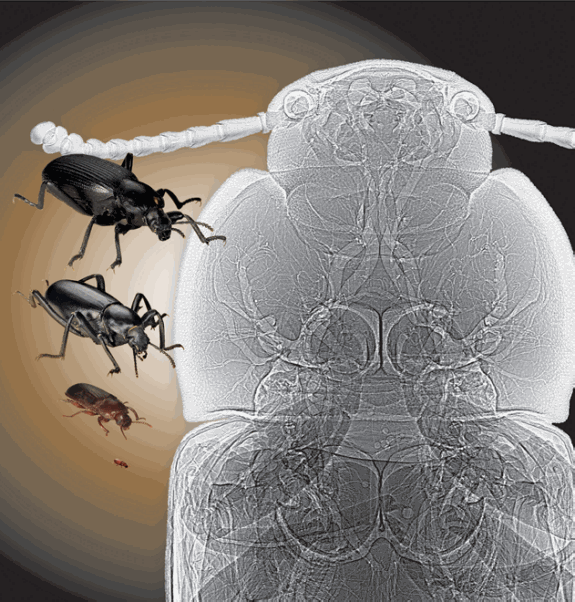If the sight of a large cockroach makes you want to scurry, you’re lucky you didn't live in the late Paleozoic Era (the earliest of three geologic eras of the Phanerozoic Eon), when atmospheric oxygen levels reached record highs and some insects evolved into giants. Imagine a B-movie “Attack of the Giant Dragonflies,” only with real dragonflies whose wingspans reached more than 2 feet in length. When oxygen levels returned to lower levels, the insect giants became extinct.
The basis of this gigantism is thought to lie in the insect respiratory system. In contrast to us vertebrates, where blood transports oxygen from the lung to the cell, insects deliver oxygen directly through a network of blind-ending tracheal tubes. As insects get bigger, this type of oxygen transport becomes far less effective. But increase the atmospheric oxygen levels, as happened in the late Paleozoic, and longer tracheal tubes can work. Greater insect sizes—even giants—can evolve.
This “oxygen-limitation” hypothesis makes sense in theory, but few studies have been carried out to see if it applies to real insects. Does the tracheal system actually limit how big insects can be? A recent article based on research carried out at X-ray Operations and Research beamline 1-ID at the Argonne Advanced Photon Source (APS), and published in the Proceedings of the National Academy of Sciences, helps confirm this hypothesis and provides a specific explanation for what limits size in beetles: the constriction of the tracheal tubes leading to the legs. The APS is funded by the U.S. Department of Energy’s Office of Science.
The team of researchers from Midwestern University, Arizona State University, and Argonne asked this question: How does the tracheal system change as body size increases in beetles? The team took advantage of richly detailed x-ray images they produced at the APS to examine the dimensions of tracheal tubes in four beetle species, ranging in body mass by a factor of 1,000.
According to biologist and study lead author Alex Kaiser (Midwestern University), “Overall, we found that larger beetle species devote a disproportionately greater fraction of their body to tracheal tubes than do smaller species. This is surprising because no other type of animal shows this pattern.”
The team focused in particular on the passageways that lead from the body core to the head and to the legs. They reasoned that these orifices may be bottlenecks for tracheal tubes, limiting how much oxygen can be delivered to the extremities.
Said Kaiser, “We were also surprised to find that the effect is most pronounced in the orifices leading to the legs, where more and more of the space is taken up by tracheal tubes in larger species.”
The team then examined the tracheal measurements of the four species to see if they could predict the largest size of currently living beetles. The head data didn’t work, predicting an outrageously proportioned foot-long beetle. In contrast, the leg data predicted a beetle that nicely matches the size of the largest living beetle, Titanus giganteus. What this means is that when it comes to limiting size, it’s not the head that matters, it’s the legs.
The synchrotron x-rays were a key tool in the study, allowing the team to visualize tracheal tubes as small as 10 microns in diameter in living beetles. Argonne physicist Wah-Keat Lee, a co-author of the study, pioneered live centimeter-sized animal imaging at the APS. “This is a lovely application of fine-scale x-ray imaging,” said Lee. “Insect tracheal systems are complex, but they’re relatively easy to study using synchrotron radiation.”
If the orifices to the legs limit beetle size, then why not just grow bigger openings? There may be genetic or developmental barriers that can't be overcome. Or, the issue may be mechanical. Insects wear their skeletons on the outside, and therefore many joints need to be narrow to work. Perhaps an oversized orifice would mean that the leg-body joint wouldn’t bend as well.
University of California, Berkeley, biologist Robert Dudley, an expert on atmospheric effects on animal movement, said, “The enhanced tracheal volumes in beetle legs shown in this study suggests that walking, running, or climbing imposes a high oxygen demand in these species, a possibility entirely consistent with the overall tendency of large beetles to rapidly crawl rather than fly away.”
This study is a first step toward understanding what controls body size in insects. It’s the legs that count in the beetles studied here, but what matters for the other hundreds of thousands of beetle species, and millions of insect species overall, is still an open question.
Whatever the factors, most people are probably happy that something keeps insects to the small size they are today. -- Jake Socha
Contact: Alex Kaiser, [email protected]
See: Alexander Kaiser, C. Jaco Klok, John J. Socha, Wah-Keat Lee, Michael C. Quinlan, and Jon F. Harrison, “ Increase in tracheal investment with beetle size supports hypothesis of oxygen limitation on insect gigantism,” Proc. Nat. Acad. Sci. USA 104(32), 13198 (August 7, 2007). DOI: 10.1073_pnas.0611544104
This work was supported by National Science Foundation Grants No. 0419704 (to J.F.H.) and IBN-0344963 (to M.C.Q.). Use of the Advanced Photon Source was supported by the U.S. Department of Energy, Office of Science, Office of Basic Energy Sciences, under Contract No. DE-AC02-06CH11357.
Argonne is a U.S. Department of Energy laboratory managed by UChicago Argonne, LLC.
This study was featured on the National Geographic Web site.

